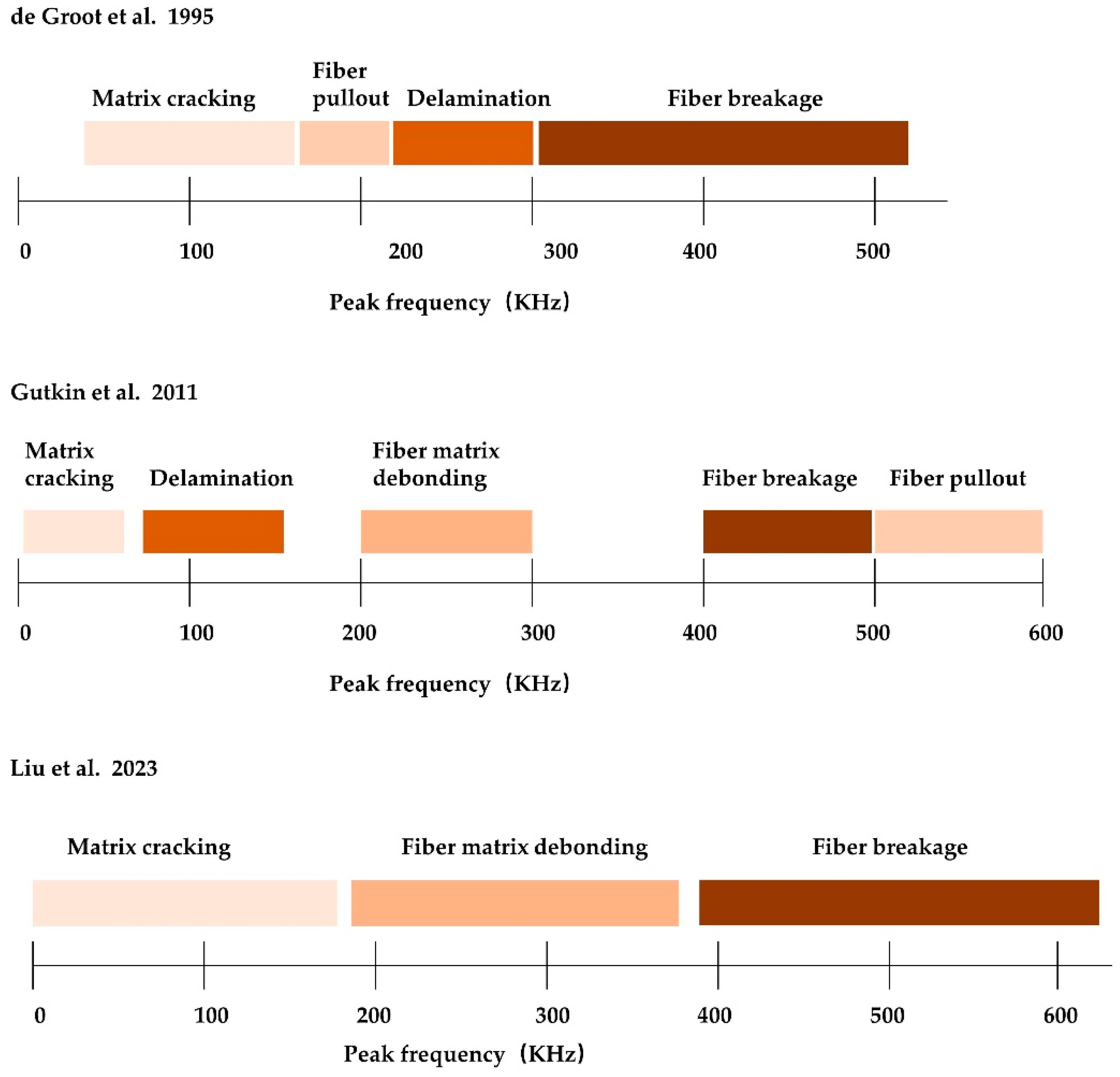Study of the Effect of NaOH Treatment on the Properties of GF/VER Composites Using AE Technique
Abstract
:1. Introduction
2. Materials and Methods
2.1. Materials and Equipment
2.2. Preparation of Modified Specimens
2.3. Fiber Tensile Property Test
2.4. Fiber Pull-Out Test
2.4.1. Preparation of Fiber Pull-Out Sample
2.4.2. Interfacial Shear Strength Test
2.5. Three-Point Flexural Test
2.5.1. Sample Preparation and Testing
2.5.2. Bending Strength Calculation
2.6. SEM Imaging
2.7. AE Signal Acquisition
2.7.1. AE Data Acquisition Device
2.7.2. Acquisition of AE Signals of Specimen Damage
2.7.3. Fiber-Reinforced Composites Damage Process
2.8. AE Signal Analysis Method
2.8.1. b-Value
2.8.2. K-Means
2.8.3. Fast Fourier Transform
3. Results and Discussion
3.1. Tensile Performance Test Results
3.2. Interfacial Shear Strength Test Results
3.3. Three-Point Bending Strength Test Results
3.4. Fracture Surface Morphology of GF/VER Composites
3.5. Principle of Reaction between NaOH and GF
3.6. Characterization of AE Signals under Three-Point Bending Loads
3.7. K-Means Damage Classification
3.8. Peak-Frequency FFT Transform
4. Conclusions
- (a)
- The interfacial properties of the GF/VER composites were improved through treatment with a 2 mol/L sodium hydroxide solution for 48 h. Compared with the original samples, the interfacial shear strength of monofilaments increased to 5.00 MPa, while fiber bundles reached 29.04 MPa, representing increases of 25.31% and 27.48%, respectively.
- (b)
- After the GF was modified by NaOH solution, the surface of the GF became rough, and the interface between the GF and VER produced physical riveting and chemical bonding, which improved the interfacial bond strength of the material. When the concentration of the NaOH solution reaches 2 mol/L and the treatment time reaches 48 h, the flexural strength of the GF/VER composites reaches a peak value of 346.72 MPa, which is enhanced by 20.96% compared to that before being modified.
- (c)
- When the GF/VER composites were subjected to a three-point bending load, the load-time curves strongly correlated with the AE characteristic signals. When the concentration of the NaOH solution reaches 2 mol/L and the treatment time reaches 48 h, the energy and counting signals during the stable growth period decrease, while the energy and counting signals during the damage period significantly increase. Additionally, the energy at the peak loading point also shows a substantial increase. The damage to modified GF/VER composites was improved, resulting in the release of more energy when damage occurred.
- (d)
- The peak frequency ranges of the six types of damage processes (matrix cracking, interlaminar debonding, fiber pullout, fiber relaxation, matrix delamination, and fiber breakage) for GF/VER composites subjected to three-point bending loads are 0~100 kHz, 100~250 kHz, 250~380 kHz, 380~450 kHz, 450~600 kHz, and 600 kHz and above, respectively.
Author Contributions
Funding
Institutional Review Board Statement
Informed Consent Statement
Data Availability Statement
Conflicts of Interest
References
- Mgbemena, C.O.; Li, D.; Lin, M.-F.; Liddel, P.D.; Katnam, K.B.; Thakur, V.K.; Nezhad, H.Y. Accelerated Microwave Curing of Fibre-Reinforced Thermoset Polymer Composites for Structural Applications: A Review of Scientific Challenges. Compos. Part A Appl. Sci. Manuf. 2018, 115, 88–103. [Google Scholar] [CrossRef]
- Rajak, D.; Pagar, D.; Menezes, P.; Linul, E. Fiber-Reinforced Polymer Composites: Manufacturing, Properties, and Applications. Polymers 2019, 11, 1667. [Google Scholar] [CrossRef]
- Gao, X.; Yang, W.; Cheng, L.; Ding, Y.; Zhan, J.; Tan, J. Epoxy Resin Composite Containing Nanocarbon-Coated Glass Fiber and Cloth for Electromagnetic Interference Shielding. J. Mater. Res. Technol. 2021, 13, 1759–1766. [Google Scholar] [CrossRef]
- Fiore, V.; Scalici, T.; Di Bella, G.; Valenza, A. A Review on Basalt Fibre and Its Composites. Compos. Part B Eng. 2015, 74, 74–94. [Google Scholar] [CrossRef]
- Tian, J.; Xu, T.; Zhang, Z.; An, L.; Li, X.; Tan, Y. Study on the Construction of Polyethyleneimine/Nano-Silica Multilayer Film on the Carbon Fiber Surfaces to Improve the Interfacial Properties of Carbon Fiber/Epoxy Composites. Compos. Interfaces 2022, 29, 361–381. [Google Scholar] [CrossRef]
- Zhou, W.; Zhao, W.; Zhang, Y.; Ding, Z. Cluster Analysis of Acoustic Emission Signals and Deformation Measurement for Delaminated Glass Fiber Epoxy Composites. Compos. Struct. 2018, 195, 349–358. [Google Scholar] [CrossRef]
- Dang, Z.-M.; Yuan, J.-K.; Zha, J.-W.; Zhou, T.; Li, S.-T.; Hu, G.-H. Fundamentals, Processes and Applications of High-Permittivity Polymer Matrix Composites. Prog. Mater. Sci. 2012, 57, 660–723. [Google Scholar] [CrossRef]
- Ma, P.-C.; Mo, S.-Y.; Tang, B.-Z.; Kim, J.-K. Dispersion, Interfacial Interaction and Re-Agglomeration of Functionalized Carbon Nanotubes in Epoxy Composites. Carbon 2010, 48, 1824–1834. [Google Scholar] [CrossRef]
- Li, N.; Li, Y.; Liu, S. Rapid Prototyping of Continuous Carbon Fiber Reinforced Polylactic Acid Composites by 3D Printing. J. Mater. Process. Technol. 2016, 238, 218–225. [Google Scholar] [CrossRef]
- Shin, P.-S.; Kim, J.-H.; Park, H.-S.; Baek, Y.-M.; Kwon, D.-J.; DeVries, K.L.; Park, J.-M. Advanced Interfacial Properties of Glass Fiber/Dopamine-Epoxy Composites Using a Microdroplet Pull-out Test and Acoustic Emission. J. Adhes. 2021, 97, 438–455. [Google Scholar] [CrossRef]
- Islam, M.S.; Pickering, K.L.; Foreman, N.J. Influence of Alkali Treatment on the Interfacial and Physico-Mechanical Properties of Industrial Hemp Fibre Reinforced Polylactic Acid Composites. Compos. Part A Appl. Sci. Manuf. 2010, 41, 596–603. [Google Scholar] [CrossRef]
- Jin, X.; Wang, W.; Xiao, C.; Lin, T.; Bian, L.; Hauser, P. Improvement of Coating Durability, Interfacial Adhesion and Compressive Strength of UHMWPE Fiber/Epoxy Composites through Plasma Pre-Treatment and Polypyrrole Coating. Compos. Sci. Technol. 2016, 128, 169–175. [Google Scholar] [CrossRef]
- Cheng, X.; Liu, J.; Han, C.; Zhang, X.; Wu, Z. Silane Coupling Agent Impact on Surface Features of Modification of Basalt Fibers and the Rheological Properties of Basalt Fiber Reinforced Asphalt. Constr. Build. Mater. 2023, 366, 130182. [Google Scholar] [CrossRef]
- Fu, Y.; Li, H.; Cao, W. Enhancing the Interfacial Properties of High-Modulus Carbon Fiber Reinforced Polymer Matrix Composites via Electrochemical Surface Oxidation and Grafting. Compos. Part A Appl. Sci. Manuf. 2020, 130, 105719. [Google Scholar] [CrossRef]
- Chen, Y.; Xu, D.; Qiu, H.; Chen, P. Improvement of the Interfacial Properties of PBO/Epoxy Composites by Online Continuous Plasma Grafting with Polyurethane. Prog. Org. Coat. 2020, 143, 105610. [Google Scholar] [CrossRef]
- Kan, Z.; Shi, H.; Zhao, E.; Wang, H. Preparation and Performance of Different Modified Ramie Fabrics Reinforced Anionic Polyamide-6 Composites. Processes 2019, 7, 226. [Google Scholar] [CrossRef]
- Xiang, Y.; Xie, Y.; Long, G. Effect of Basalt Fiber Surface Silane Coupling Agent Coating on Fiber-Reinforced Asphalt: From Macro-Mechanical Performance to Micro-Interfacial Mechanism. Constr. Build. Mater. 2018, 179, 107–116. [Google Scholar] [CrossRef]
- Kolářová, K.; Vosmanská, V.; Rimpelová, S.; Švorčík, V. Effect of Plasma Treatment on Cellulose Fiber. Cellulose 2013, 20, 953–961. [Google Scholar] [CrossRef]
- Zhang, X.Z.; Song, Y.J.; Huang, Y.D. Properties of Silsesquioxane Coating Modified Carbon Fibre/Polyarylacetylene Composites. Compos. Sci. Technol. 2007, 67, 3014–3022. [Google Scholar] [CrossRef]
- Ramamoorthy, S.K.; Bakare, F.; Herrmann, R.; Skrifvars, M. Performance of Biocomposites from Surface Modified Regenerated Cellulose Fibers and Lactic Acid Thermoset Bioresin. Cellulose 2015, 22, 2507–2528. [Google Scholar] [CrossRef]
- Honarvar, F.; Varvani-Farahani, A. A Review of Ultrasonic Testing Applications in Additive Manufacturing: Defect Evaluation, Material Characterization, and Process Control. Ultrasonics 2020, 108, 106227. [Google Scholar] [CrossRef]
- Bayraktar, E.; Antolovich, S.D.; Bathias, C. New Developments in Non-Destructive Controls of the Composite Materials and Applications in Manufacturing Engineering. J. Mater. Process. Technol. 2008, 206, 30–44. [Google Scholar] [CrossRef]
- Barile, C.; Casavola, C.; Pappalettera, G.; Vimalathithan, P.K. Damage Characterization in Composite Materials Using Acoustic Emission Signal-Based and Parameter-Based Data. Compos. Part B Eng. 2019, 178, 107469. [Google Scholar] [CrossRef]
- Dong, L.; Tao, Q.; Hu, Q.; Deng, S.; Chen, Y.; Luo, Q.; Zhang, X. Acoustic Emission Source Location Method and Experimental Verification for Structures Containing Unknown Empty Areas. Int. J. Min. Sci. Technol. 2022, 32, 487–497. [Google Scholar] [CrossRef]
- Sarasini, F.; Tirillò, J.; Valente, M.; Valente, T.; Cioffi, S.; Iannace, S.; Sorrentino, L. Effect of Basalt Fiber Hybridization on the Impact Behavior under Low Impact Velocity of Glass/Basalt Woven Fabric/Epoxy Resin Composites. Compos. Part A Appl. Sci. Manuf. 2013, 47, 109–123. [Google Scholar] [CrossRef]
- Scholz, M.-S.; Drinkwater, B.W.; Trask, R.S. Ultrasonic Assembly of Anisotropic Short Fibre Reinforced Composites. Ultrasonics 2014, 54, 1015–1019. [Google Scholar] [CrossRef]
- Jung, D.; Yu, W.-R.; Na, W. Investigation of Ib-Values for Determining Fracture Modes in Fiber-Reinforced Composite Materials by Acoustic Emission. Materials 2021, 14, 3641. [Google Scholar] [CrossRef] [PubMed]
- Ciampa, F.; Meo, M. A New Algorithm for Acoustic Emission Localization and Flexural Group Velocity Determination in Anisotropic Structures. Compos. Part A Appl. Sci. Manuf. 2010, 41, 1777–1786. [Google Scholar] [CrossRef]
- Xu, J.; Shu, S.; Han, Q.; Liu, C. Experimental Research on Bond Behavior of Reinforced Recycled Aggregate Concrete Based on the Acoustic Emission Technique. Constr. Build. Mater. 2018, 191, 1230–1241. [Google Scholar] [CrossRef]
- Geng, Z.; Puhan, D.; Reddyhoff, T. Using Acoustic Emission to Characterize Friction and Wear in Dry Sliding Steel Contacts. Tribol. Int. 2019, 134, 394–407. [Google Scholar] [CrossRef]
- Azadi, M.; Sayar, H.; Ghasemi-Ghalebahman, A.; Jafari, S.M. Tensile Loading Rate Effect on Mechanical Properties and Failure Mechanisms in Open-Hole Carbon Fiber Reinforced Polymer Composites by Acoustic Emission Approach. Compos. Part B Eng. 2019, 158, 448–458. [Google Scholar] [CrossRef]
- McCrory, J.P.; Al-Jumaili, S.K.; Crivelli, D.; Pearson, M.R.; Eaton, M.J.; Featherston, C.A.; Guagliano, M.; Holford, K.M.; Pullin, R. Damage Classification in Carbon Fibre Composites Using Acoustic Emission: A Comparison of Three Techniques. Compos. Part B Eng. 2015, 68, 424–430. [Google Scholar] [CrossRef]
- Baker, C.; Morscher, G.N.; Pujar, V.V.; Lemanski, J.R. Transverse Cracking in Carbon Fiber Reinforced Polymer Composites: Modal Acoustic Emission and Peak Frequency Analysis. Compos. Sci. Technol. 2015, 116, 26–32. [Google Scholar] [CrossRef]
- de Groot, P.J.; Wijnen, P.A.M.; Janssen, R.B.F. Real-Time Frequency Determination of Acoustic Emission for Different Fracture Mechanisms in Carbon/Epoxy Composites. Compos. Sci. Technol. 1995, 55, 405–412. [Google Scholar] [CrossRef]
- Gutkin, R.; Green, C.J.; Vangrattanachai, S.; Pinho, S.T.; Robinson, P.; Curtis, P.T. On Acoustic Emission for Failure Investigation in CFRP: Pattern Recognition and Peak Frequency Analyses. Mech. Syst. Signal Process. 2011, 25, 1393–1407. [Google Scholar] [CrossRef]
- BarilE, C.; Casavola, C.; Pappaletter, G.; Vimalathithan, P.K. Experimental Wavelet Analysis of Acoustic Emission Signal Propagation in CFRP. Eng. Fract. Mech. 2019, 210, 400–407. [Google Scholar] [CrossRef]
- Rubio, M.A.; Bethune, K.; Urquia, A.; St-Pierre, J. Proton Exchange Membrane Fuel Cell Failure Mode Early Diagnosis with Wavelet Analysis of Electrochemical Noise. Int. J. Hydrogen Energy 2016, 41, 14991–15001. [Google Scholar] [CrossRef]
- Fu, T.; Zhang, Z.; Liu, Y.; Leng, J. Development of an Artificial Neural Network for Source Localization Using a Fiber Optic Acoustic Emission Sensor Array. Struct. Health Monit. 2015, 14, 168–177. [Google Scholar] [CrossRef]
- Amenabar, I.; Mendikute, A.; Lopez-Arraiza, A.; Lizaranzu, M.; Aurrekoetxea, J. Comparison and Analysis of Non-Destructive Testing Techniques Suitable for Delamination Inspection in Wind Turbine Blades. Compos. Part B Eng. 2011, 42, 1298–1305. [Google Scholar] [CrossRef]
- Mohammadi, R.; Najafabadi, M.A.; Saeedifar, M.; Yousefi, J.; Minak, G. Correlation of Acoustic Emission with Finite Element Predicted Damages in Open-Hole Tensile Laminated Composites. Compos. Part B Eng. 2017, 108, 427–435. [Google Scholar] [CrossRef]
- Nikbakht, M.; Yousefi, J.; Hosseini-Toudeshky, H.; Minak, G. Delamination Evaluation of Composite Laminates with Different Interface Fiber Orientations Using Acoustic Emission Features and Micro Visualization. Compos. Part B Eng. 2017, 113, 185–196. [Google Scholar] [CrossRef]
- Anaya-Ramirez, R.C.; Rios-Soberanis, C.R.; Herrera-Franco, P.J. Identification of Micro-failure Processes of HDPE -henequen Fiber Composite Material by Using Acoustic Emission Monitoring: Effect of Fiber Surface Modification. Polym. Compos. 2023, 44, 2697–2709. [Google Scholar] [CrossRef]
- Scholey, J.J.; Wilcox, P.D.; Wisnom, M.R.; Friswell, M.I. Quantitative Experimental Measurements of Matrix Cracking and Delamination Using Acoustic Emission. Compos. Part A Appl. Sci. Manuf. 2010, 41, 612–623. [Google Scholar] [CrossRef]
- Bussiba, A.; Kupiec, M.; Ifergane, S.; Piat, R.; Bohlke, T. Damage Evolution and Fracture Events Sequence in Various Composites by Acoustic Emission Technique. Compos. Sci. Technol. 2007, 68, 1144–1155. [Google Scholar] [CrossRef]
- Sasikumar, T.; RajendraBoopathy, S.; Usha, K.M.; Vasudev, E.S. Failure Strength Prediction of Unidirectional Tensile Coupons Using Acoustic Emission Peak Amplitude and Energy Parameter with Artificial Neural Networks. Compos. Sci. Technol. 2009, 69, 1151–1155. [Google Scholar] [CrossRef]
- Kong, H.; Xu, Q.; Yu, M. Microstructural Changes of Aramid Fiber Due to Reaction with Toluene 2,4-Diisocyanate under Tension in scCO2. Polymers 2019, 11, 1110. [Google Scholar] [CrossRef]
- Tanaka, K.; Minoshima, K.; Grela, W.; Komai, K. Characterization of the Aramid/Epoxy Interfacial Properties by Means of Pull-out Test and Influence of Water Absorption. Compos. Sci. Technol. 2002, 62, 2169–2177. [Google Scholar] [CrossRef]
- Gu, J.; Xie, Z.; Wang, S.; Sun, H.; Zhang, X. Thermo-Mechanical Modeling of Woven Fabric Reinforced Shape Memory Polymer Composites. Mech. Adv. Mater. Struct. 2019, 26, 1042–1052. [Google Scholar] [CrossRef]
- ASTM D790-02; Standard Test Methods for Flexural Strength of Unreinforced and Reinforced Plastics. Annual Book of ASTM Standards. Volume 06.04, ASTM International: West Conshohocken, PA, USA, 2002.
- Guo, F.; Li, W.; Jiang, P.; Chen, F.; Liu, Y. Deep Learning Approach for Damage Classification Based on Acoustic Emission Data in Composite Materials. Materials 2022, 15, 4270. [Google Scholar] [CrossRef]
- Grabowska, J.; Palacz, M.; Krawczuk, M. Damage Identification by Wavelet Analysis. Mech. Syst. Signal Proc. 2008, 22, 1623–1635. [Google Scholar] [CrossRef]
- Arumugam, V.; Kumar, C.S.; Santulli, C.; Sarasini, E.; Stanley, A.J. A Global Method for the Identification of Failure Modes in Fiberglass Using Acoustic Emission. J. Test. Eval. 2011, 39, 954–966. [Google Scholar] [CrossRef]
- Colombo, I.S.; Main, I.G.; Forde, M.C. Assessing Damage of Reinforced Concrete Beam Using “b-Value” Analysis of Acoustic Emission Signals. J. Mater. Civ. Eng. 2003, 15, 280–286. [Google Scholar] [CrossRef]
- Sagar, R.V.; Prasad, B.K.R.; Kumar, S.S. An Experimental Study on Cracking Evolution in Concrete and Cement Mortar by the B-Value Analysis of Acoustic Emission Technique. Cem. Concr. Res. 2012, 42, 1094–1104. [Google Scholar] [CrossRef]
- Chelliah, S.K.; Parameswaran, P.; Ramasamy, S.; Vellayaraj, A.; Subramanian, S. Optimization of Acoustic Emission Parameters to Discriminate Failure Modes in Glass–Epoxy Composite Laminates Using Pattern Recognition. Struct. Health Monit. 2019, 18, 1253–1267. [Google Scholar] [CrossRef]
- Al-Jumaili, S.K.; Holford, K.M.; Eaton, M.J.; McCrory, J.P.; Pearson, M.R.; Pullin, R. Classification of Acoustic Emission Data from Buckling Test of Carbon Fibre Panel Using Unsupervised Clustering Techniques. Struct. Health Monit. 2015, 14, 241–251. [Google Scholar] [CrossRef]
- Li, L.; Swolfs, Y.; Straumit, I.; Yan, X.; Lomov, S.V. Cluster Analysis of Acoustic Emission Signals for 2D and 3D Woven Carbon Fiber/Epoxy Composites. J. Compos. Mater. 2016, 50, 1921–1935. [Google Scholar] [CrossRef]
- Warren Liao, T.; Ting, C.-F.; Qu, J.; Blau, P.J. A Wavelet-Based Methodology for Grinding Wheel Condition Monitoring. Int. J. Mach. Tools Manuf. 2007, 47, 580–592. [Google Scholar] [CrossRef]
- Liu, Y.; Huang, K.; Wang, Z.; Li, Z.; Chen, L.; Shi, Q.; Yu, S.; Li, Z.; Zhang, L.; Guo, L. Cross-Scale Data-Based Damage Identification of CFRP Laminates Using Acoustic Emission and Deep Learning. Eng. Fract. Mech. 2023, 294, 109724. [Google Scholar] [CrossRef]
- Crundwell, F.K. On the Mechanism of the Dissolution of Quartz and Silica in Aqueous Solutions. ACS Omega 2017, 2, 1116–1127. [Google Scholar] [CrossRef]
- Sensui, K.; Tarui, T.; Miyamae, T.; Sato, C. Evidence of Chemical-Bond Formation at the Interface between an Epoxy Polymer and an Isocyanate Primer. Chem. Commun. 2019, 55, 14833–14836. [Google Scholar] [CrossRef]
- Sumiya, Y.; Tsuji, Y.; Yoshizawa, K. Peel Adhesion Strength between Epoxy Resin and Hydrated Silica Surfaces: A Density Functional Theory Study. ACS Omega 2022, 7, 17393–17400. [Google Scholar] [CrossRef] [PubMed]
- Yeon, J.; Chowdhury, S.C.; Gillespie, J.W., Jr. Hydroxylation and Water-Surface Interaction for S-Glass and Silica Glass Using ReaxFF Based Molecular Dynamics Simulations. Appl. Surf. Sci. 2023, 608, 155078. [Google Scholar] [CrossRef]
- Deng, J.; Song, Y.; Lan, Z.; Xu, Z.; Chen, Y.; Yang, B.; Hao, H. The Surface Modification Effect on the Interfacial Properties of Glass Fiber-Reinforced Epoxy: A Molecular Dynamics Study. Nanotechnol. Rev. 2022, 11, 1143–1157. [Google Scholar] [CrossRef]
- Lin, Z.; Shi, C.; Huang, X.; Tang, C.; Yuan, Y. A Study on Damage of T800 Carbon Fiber/Epoxy Composites under In-Plane Shear Using Acoustic Emission and Digital Image Correlation. Polymers 2023, 15, 4319. [Google Scholar] [CrossRef]
- Tabrizi, I.E.; Kefal, A.; Zanjani, J.S.M.; Akalin, C.; Yildiz, M. Experimental and Numerical Investigation on Fracture Behavior of Glass/Carbon Fiber Hybrid Composites Using Acoustic Emission Method and Refined Zigzag Theory. Compos. Struct. 2019, 223, 110971. [Google Scholar] [CrossRef]
- Fotouhi, M.; Najafabadi, M.A. Acoustic Emission-Based Study to Characterize the Initiation of Delamination in Composite Materials. J. Thermoplast. Compos. Mater. 2016, 29, 519–537. [Google Scholar] [CrossRef]

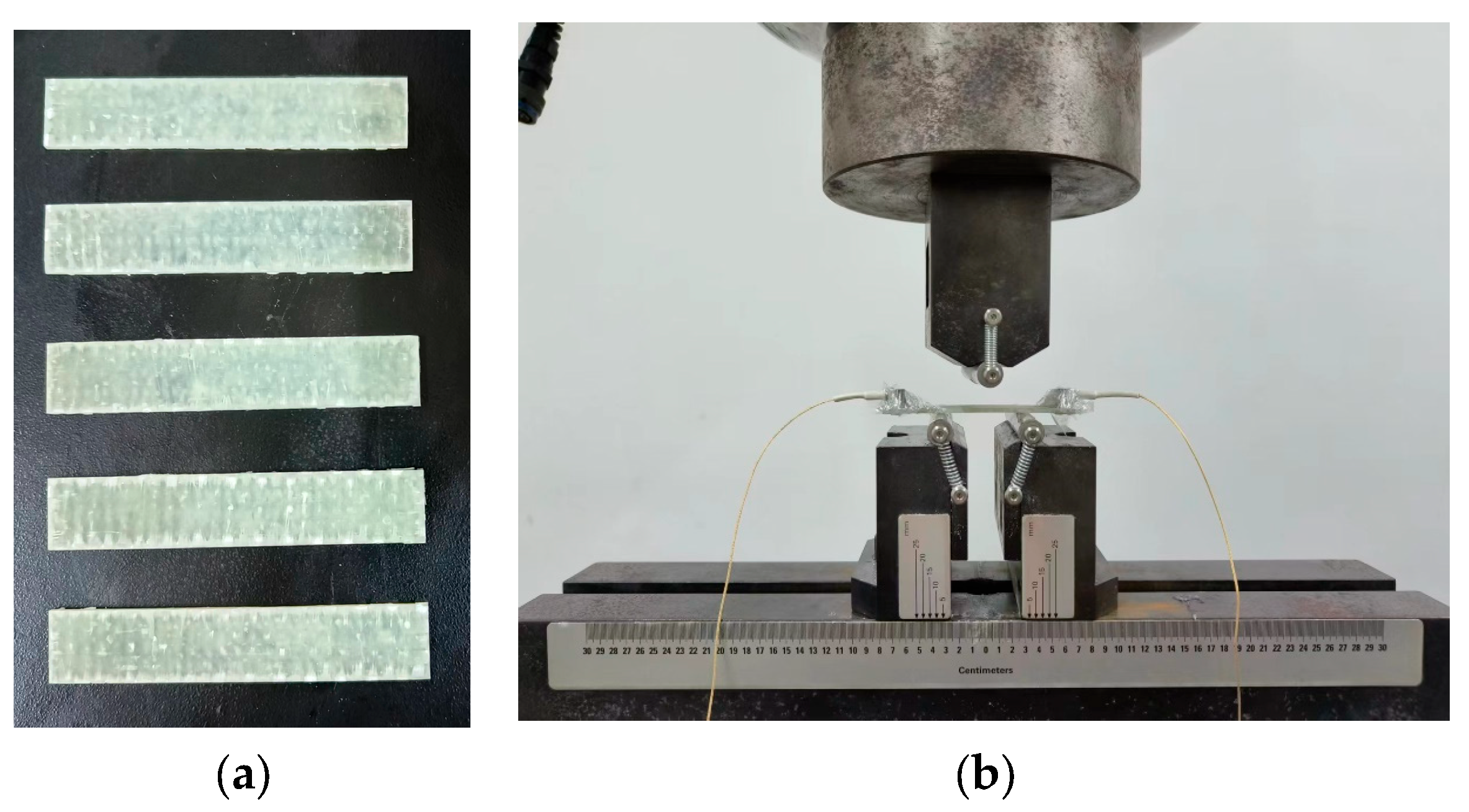
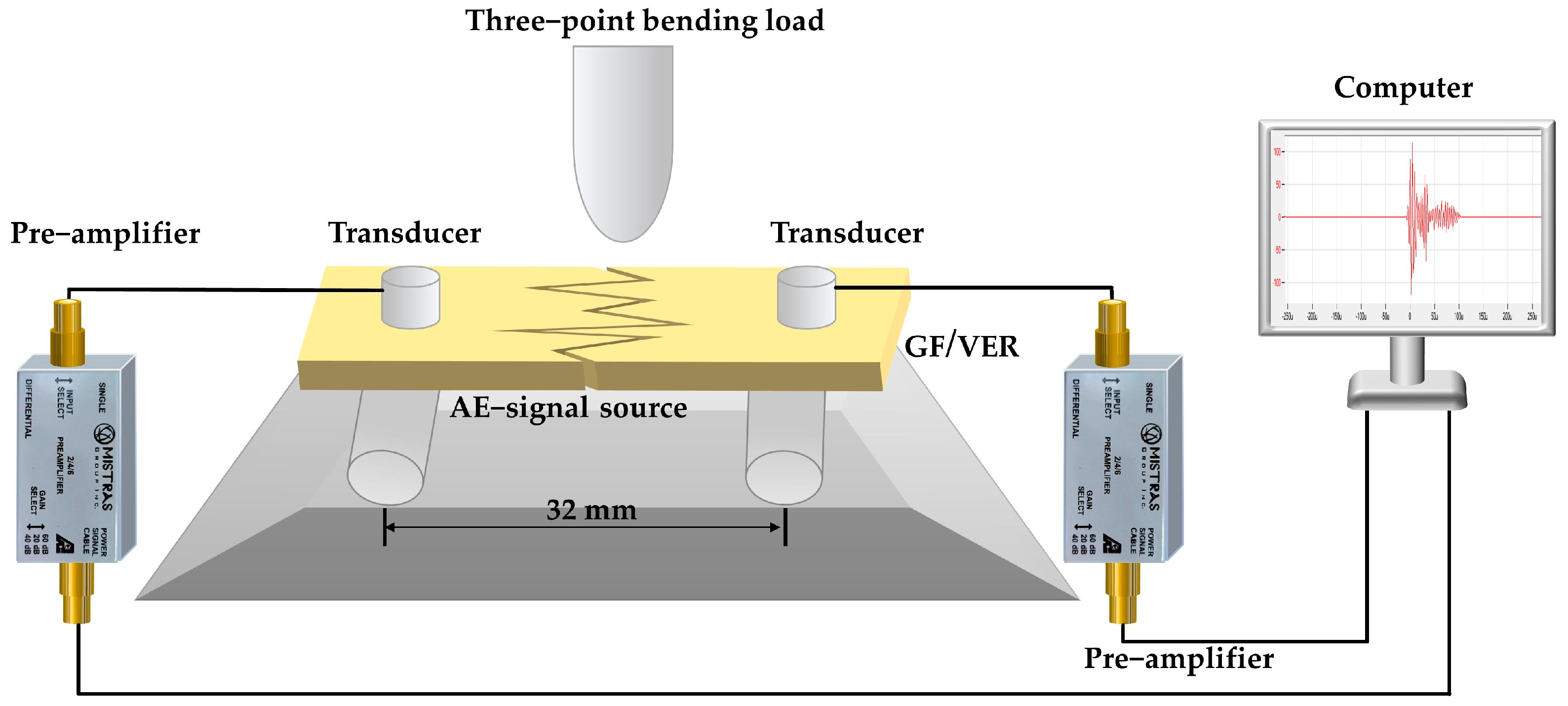
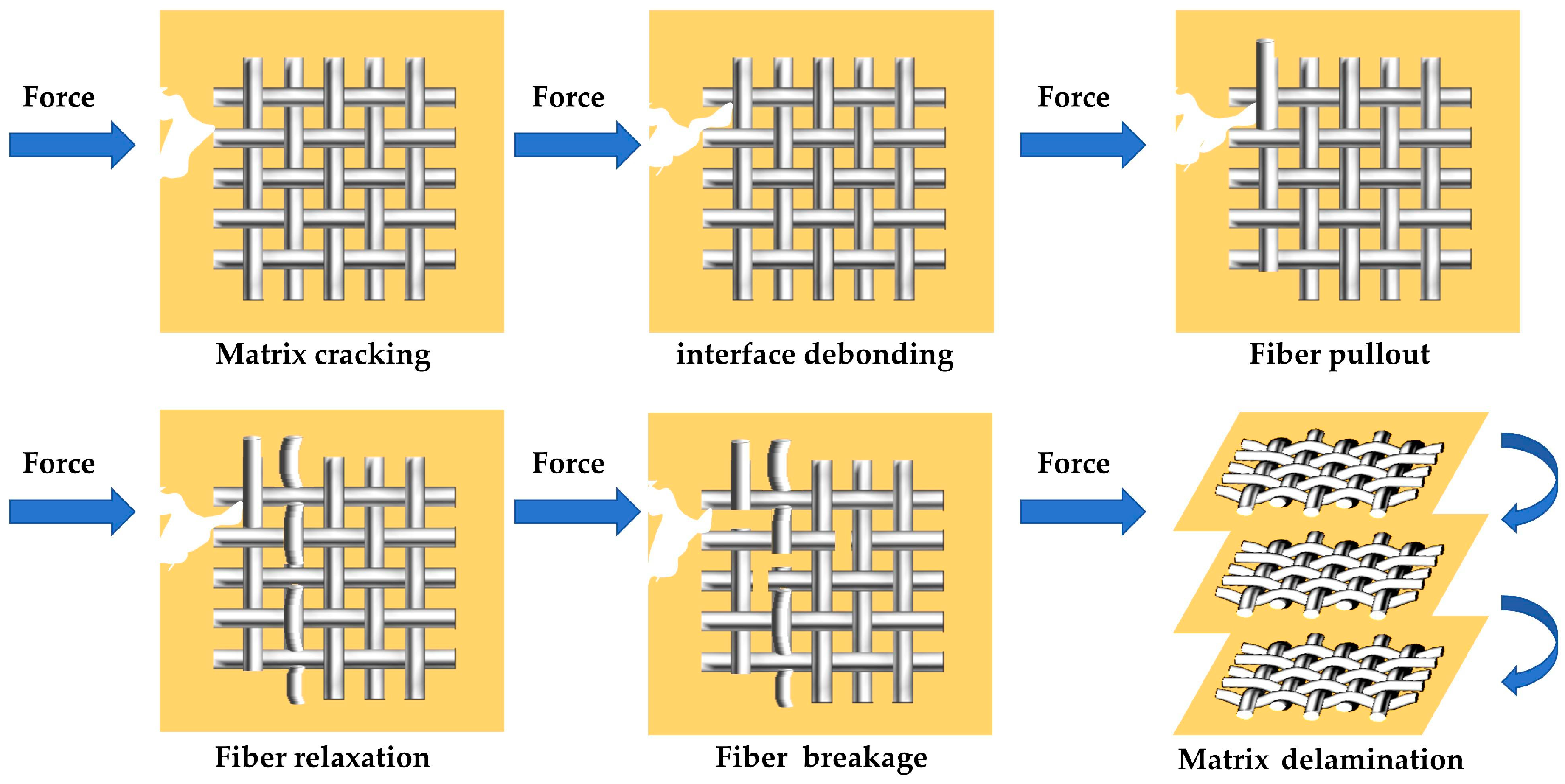
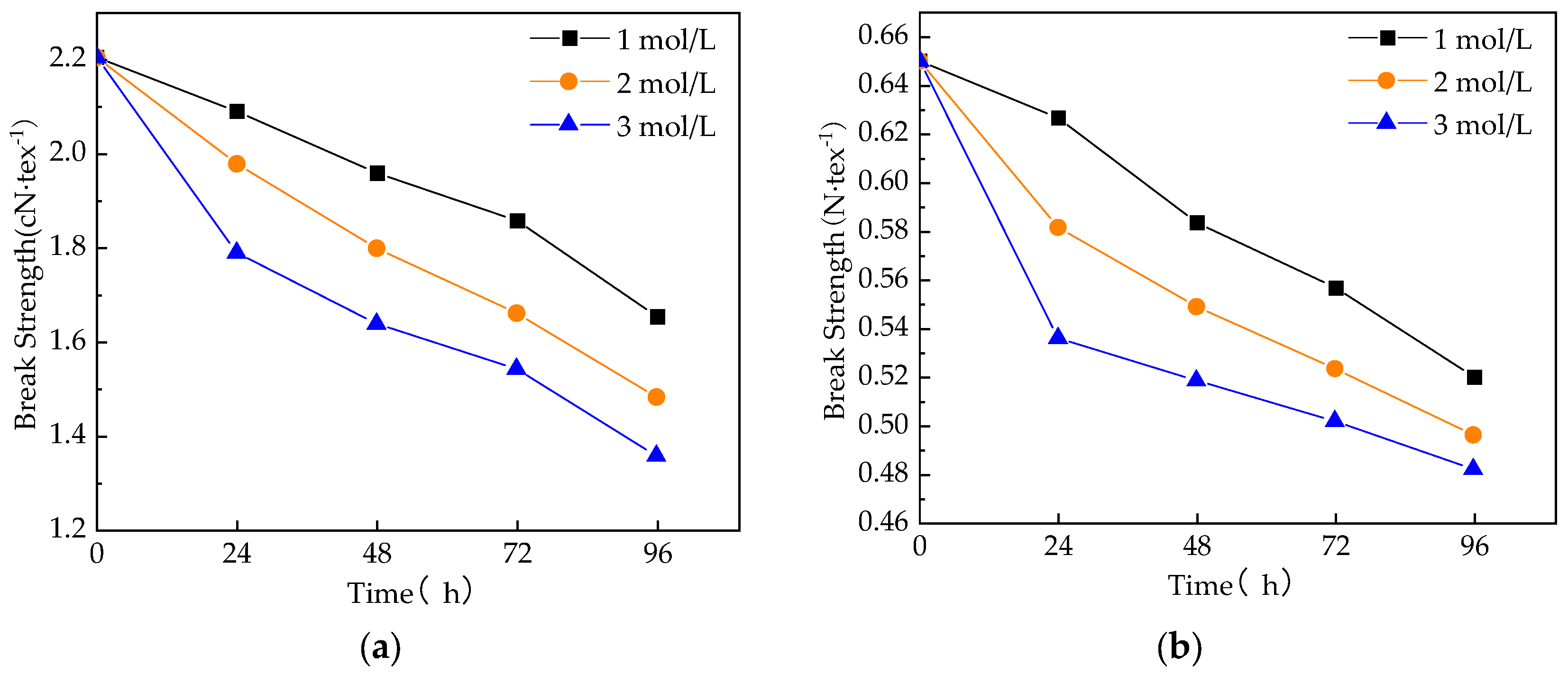
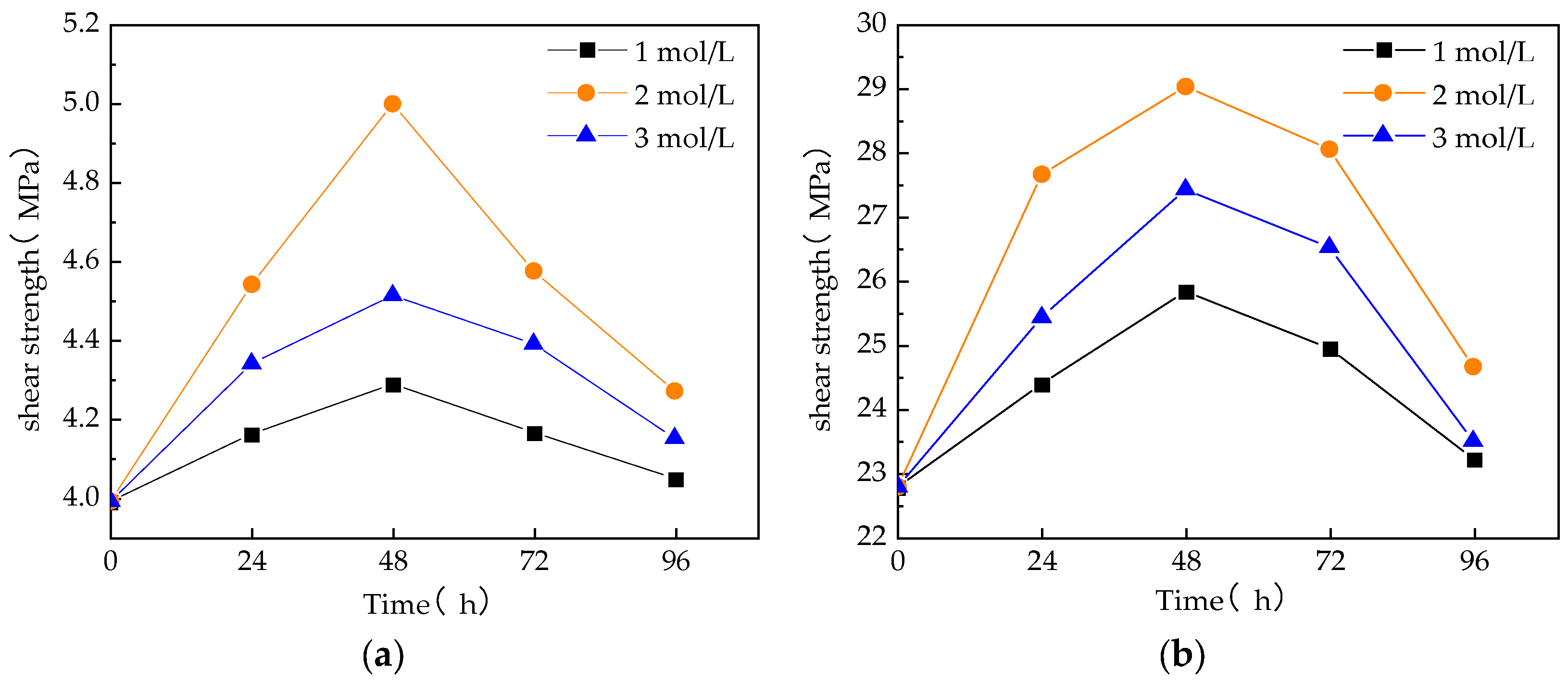
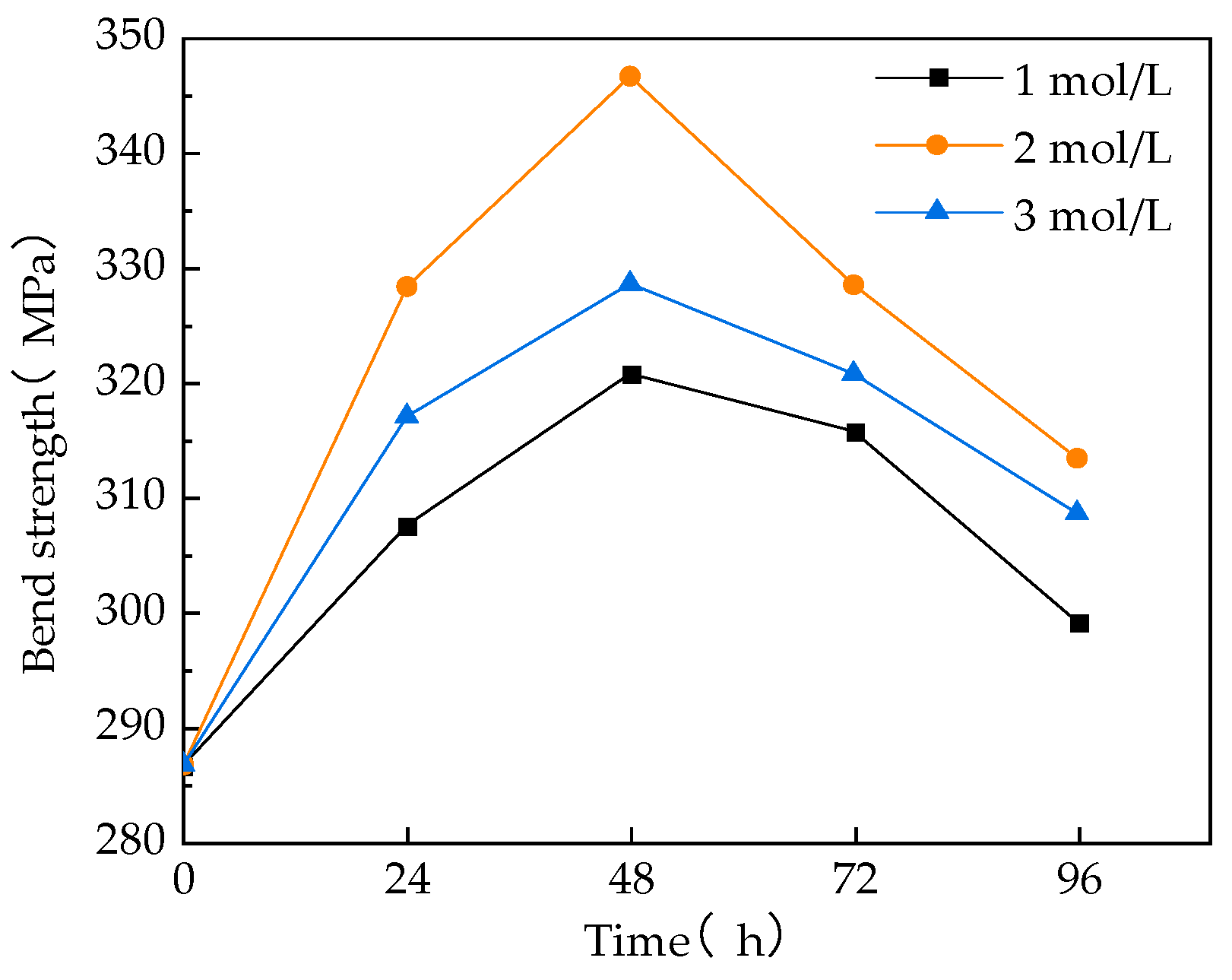
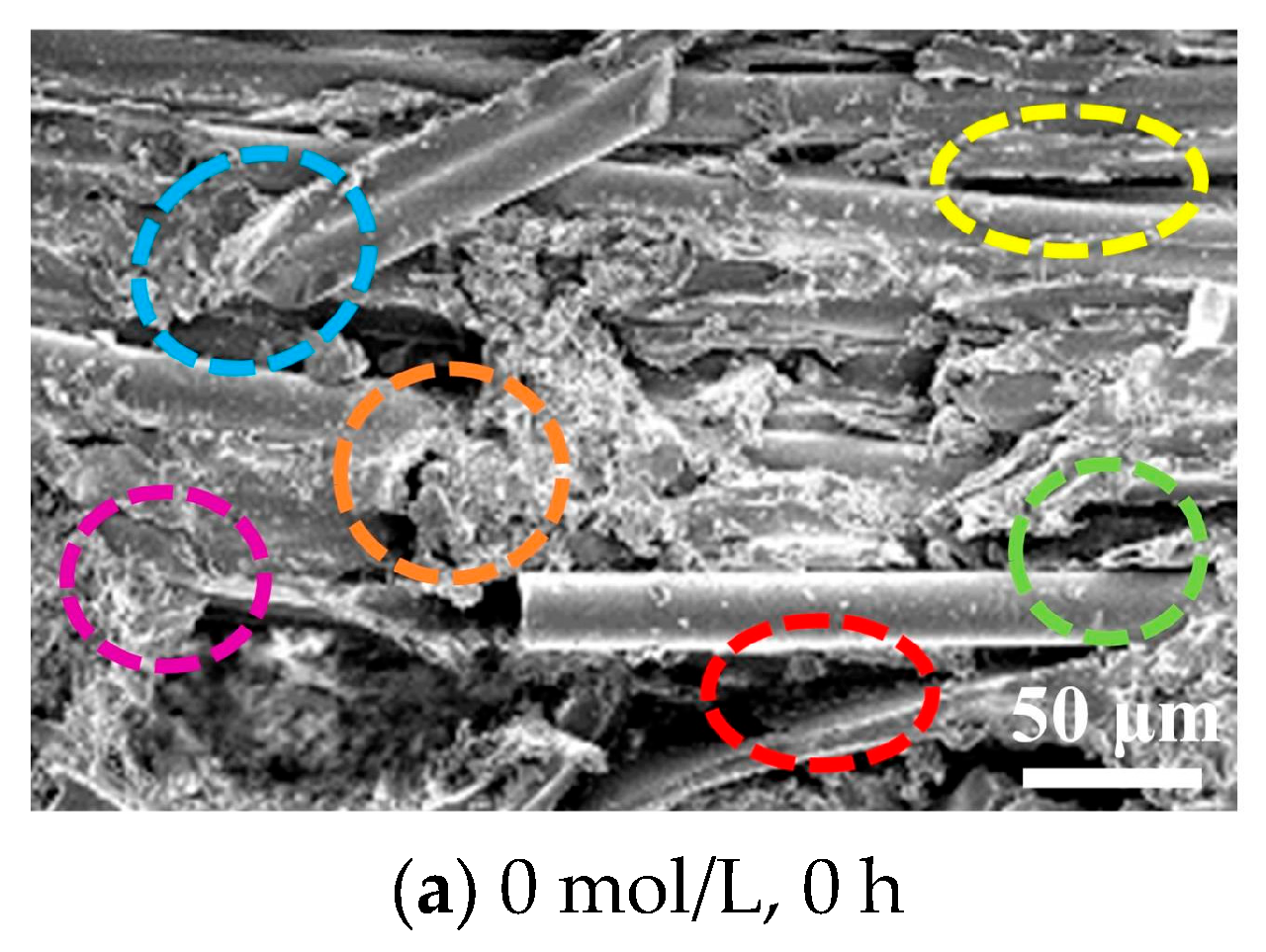

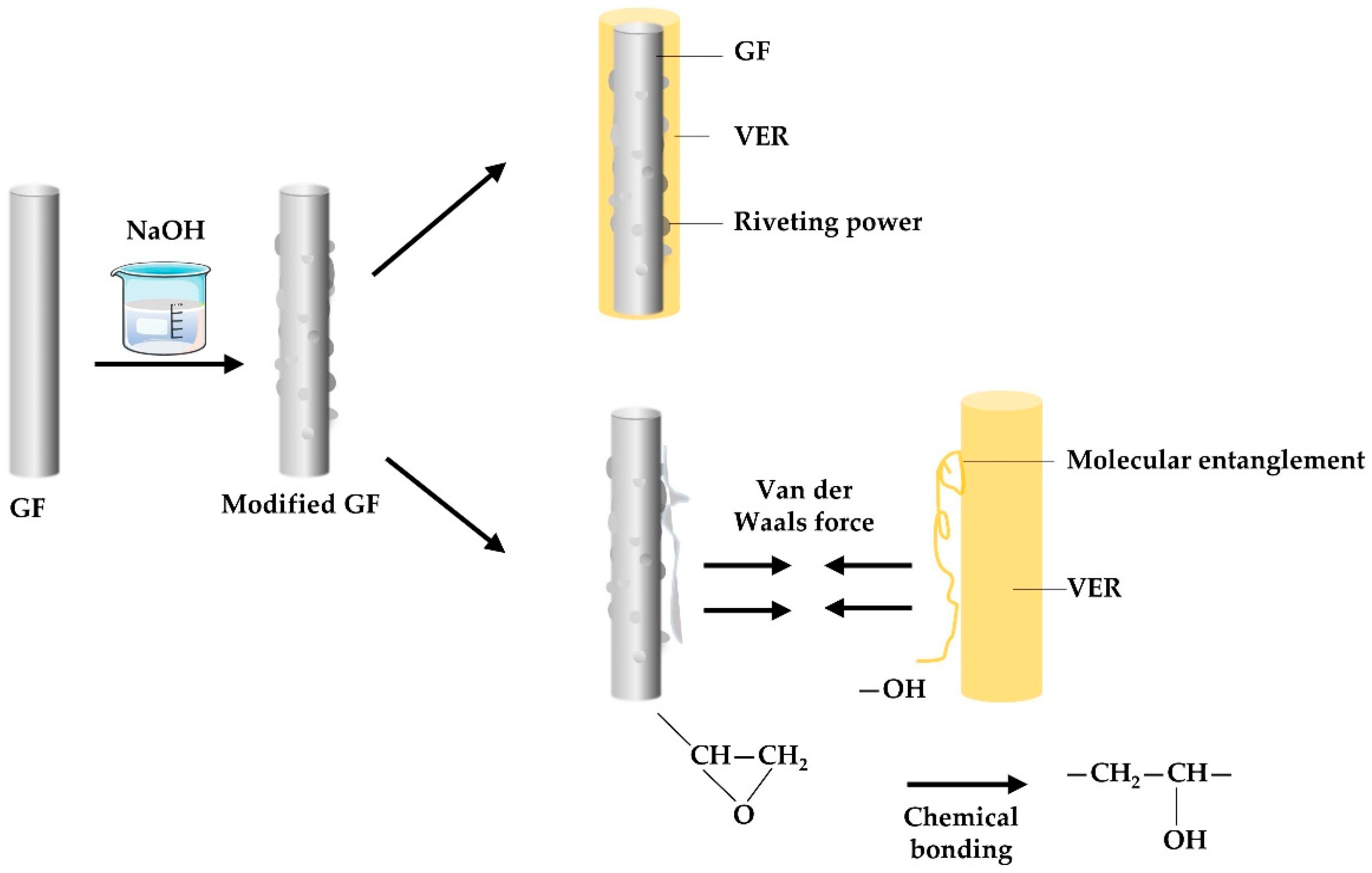
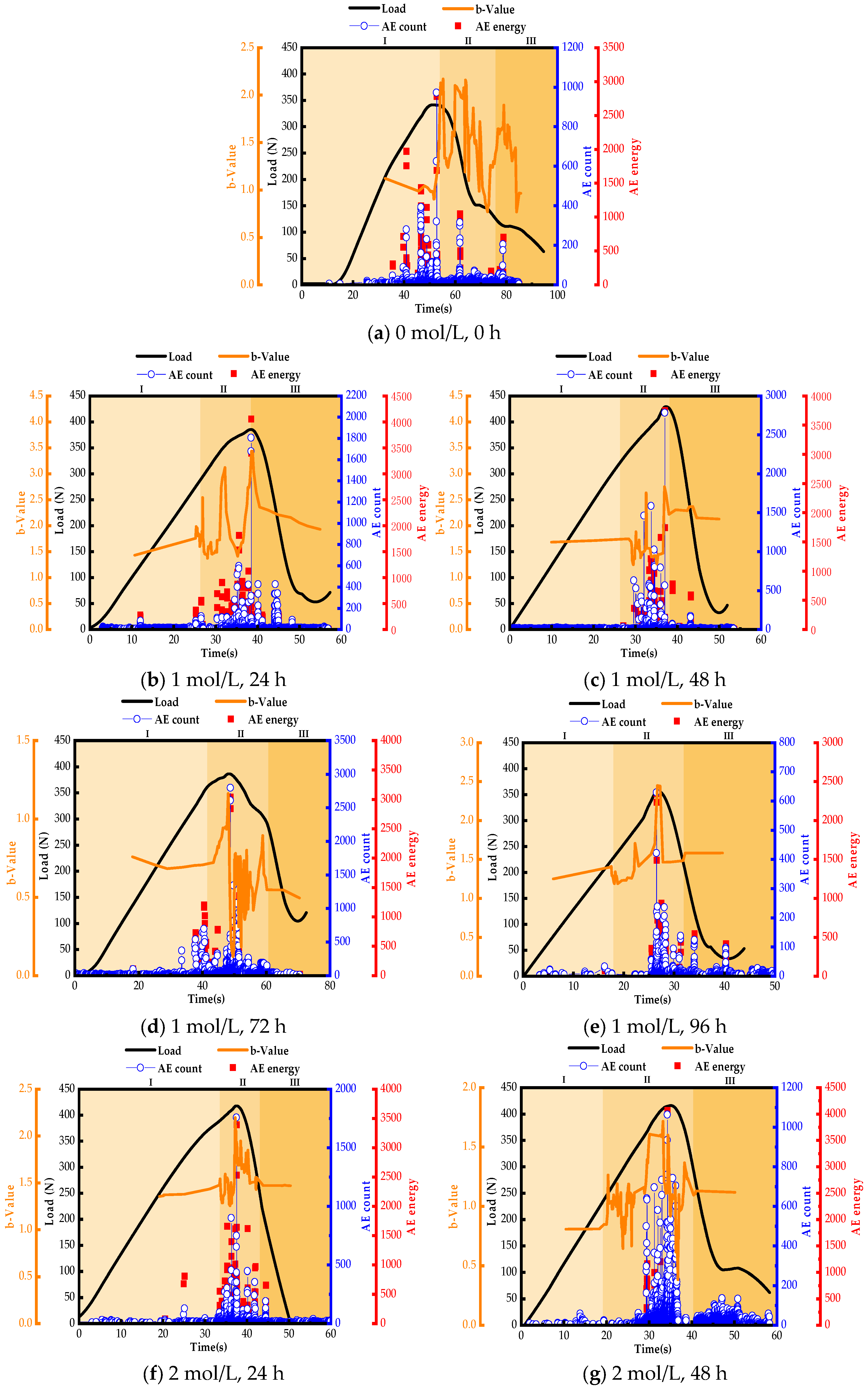
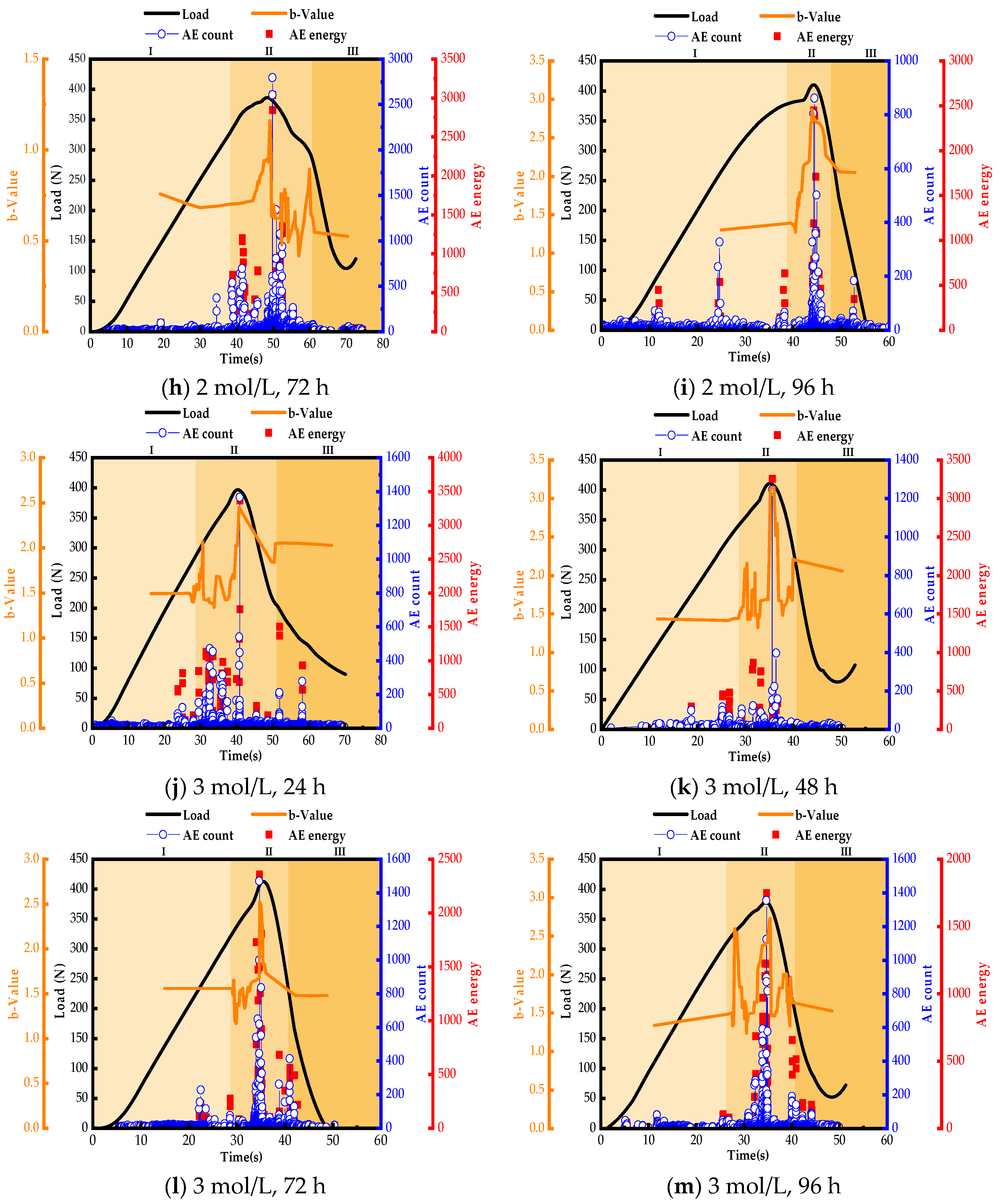
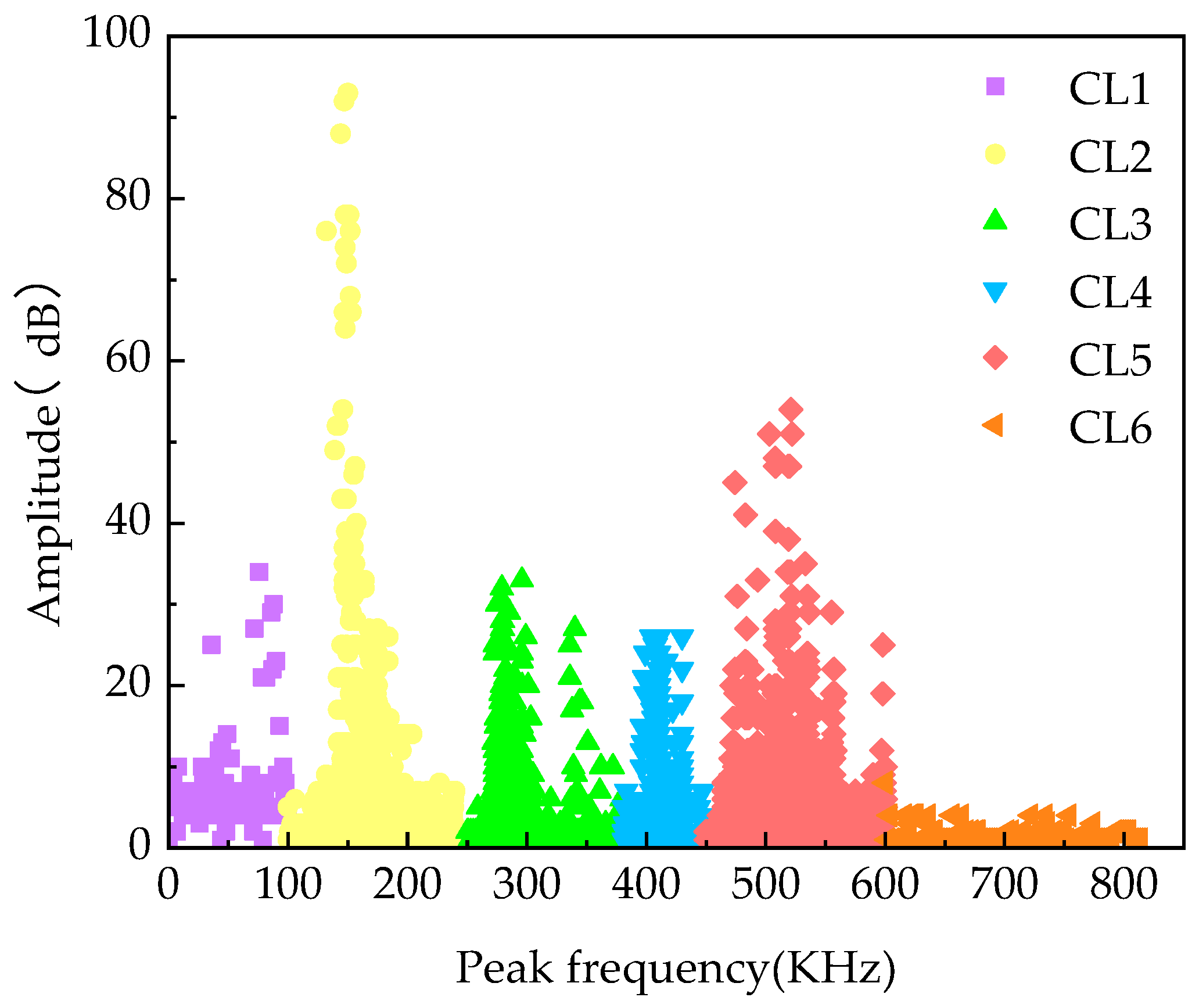
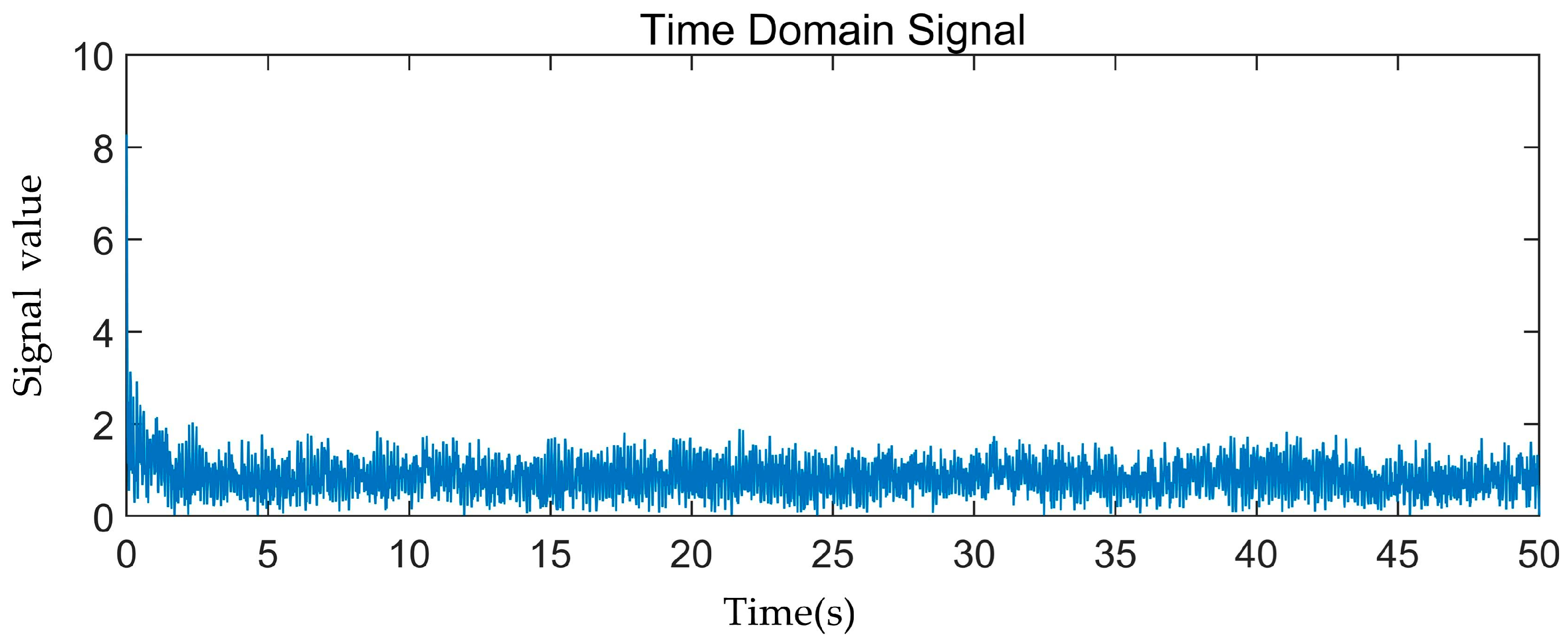
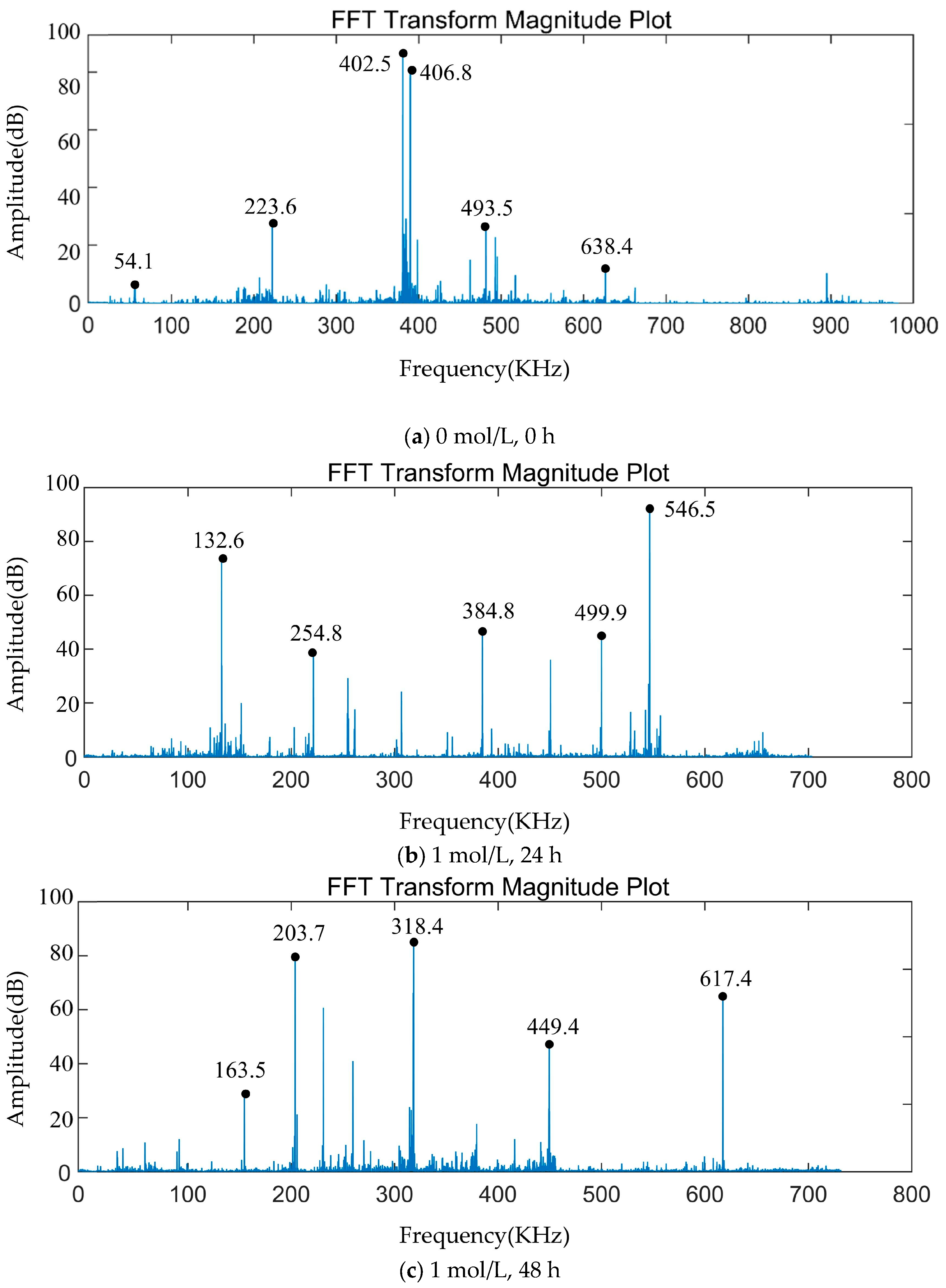
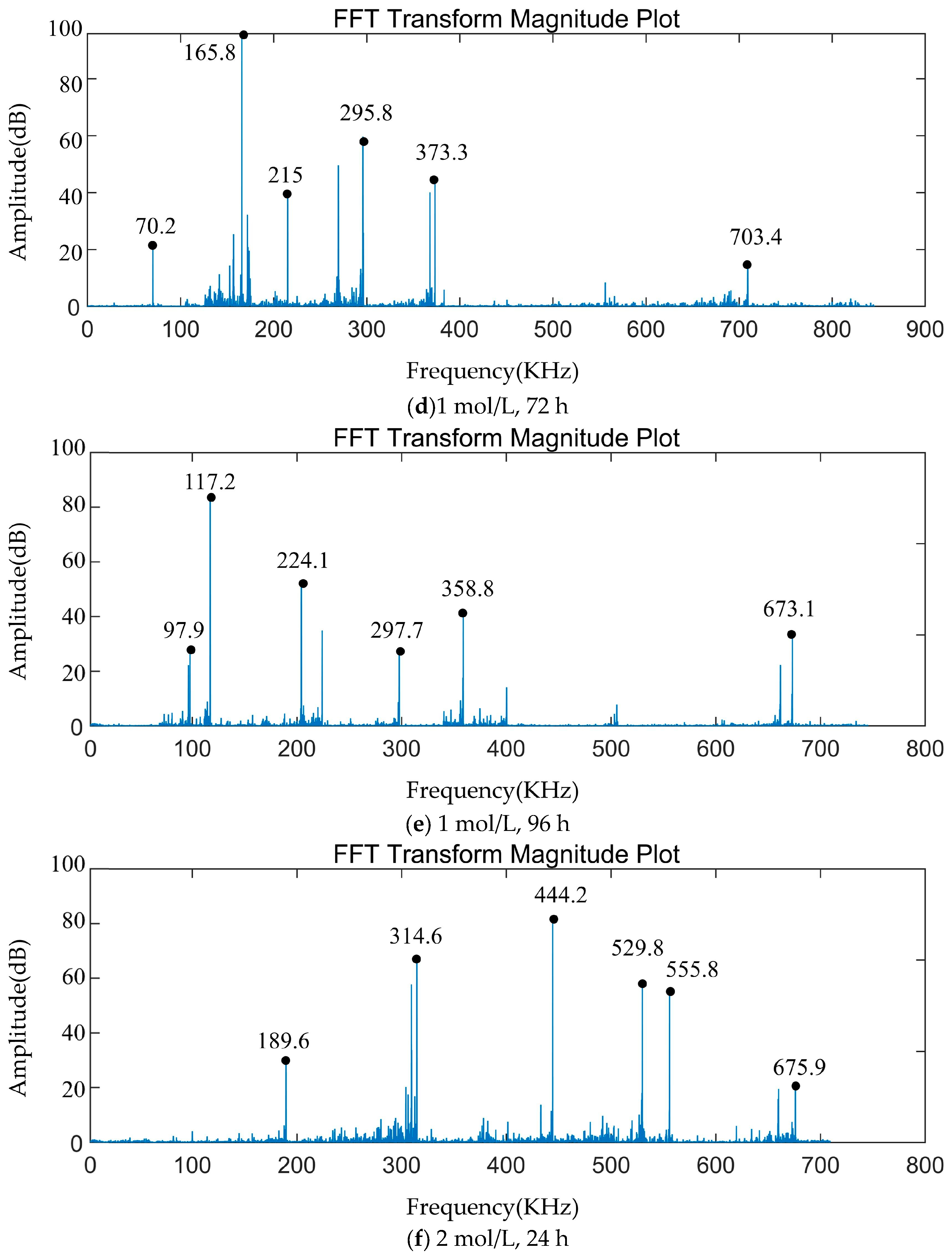
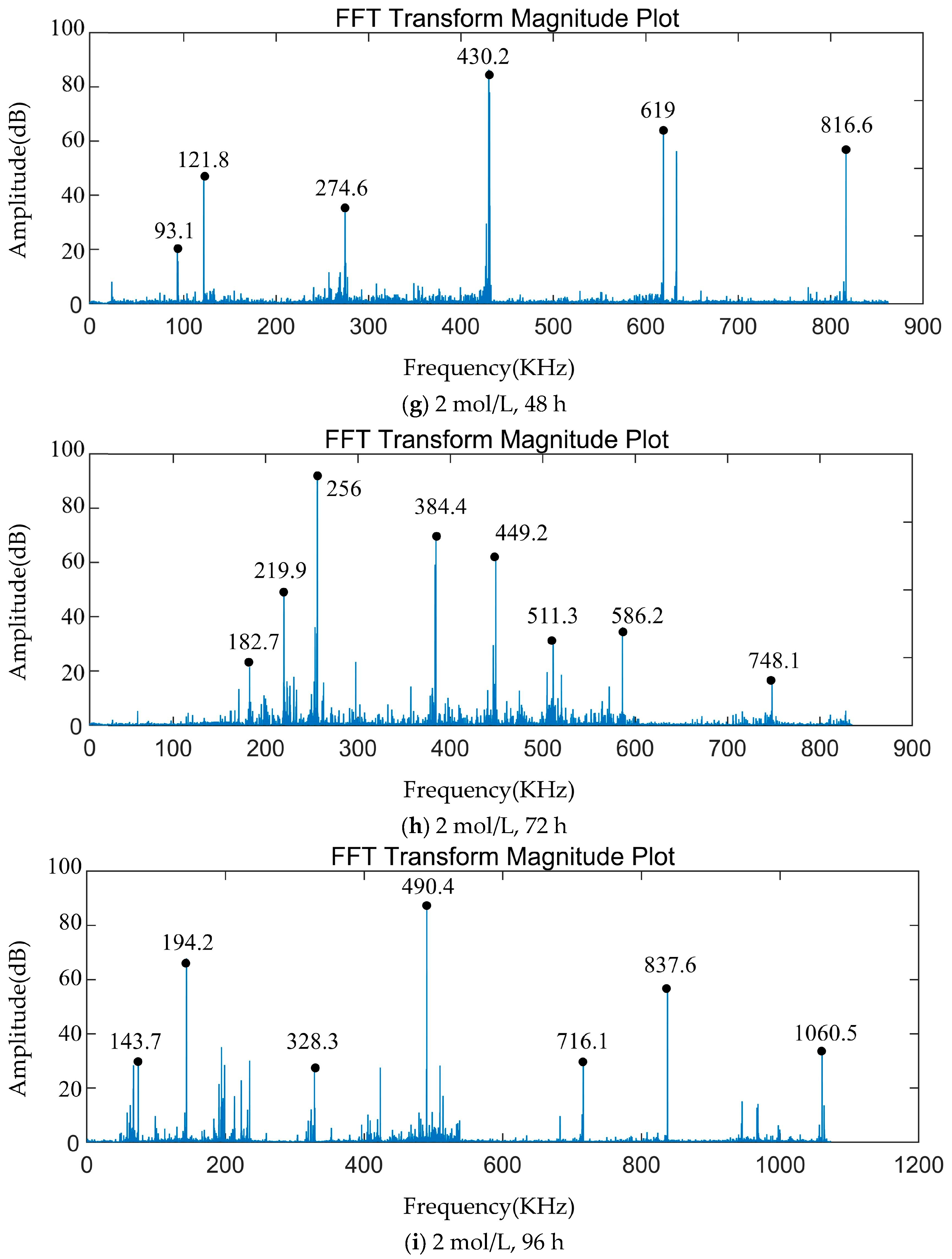
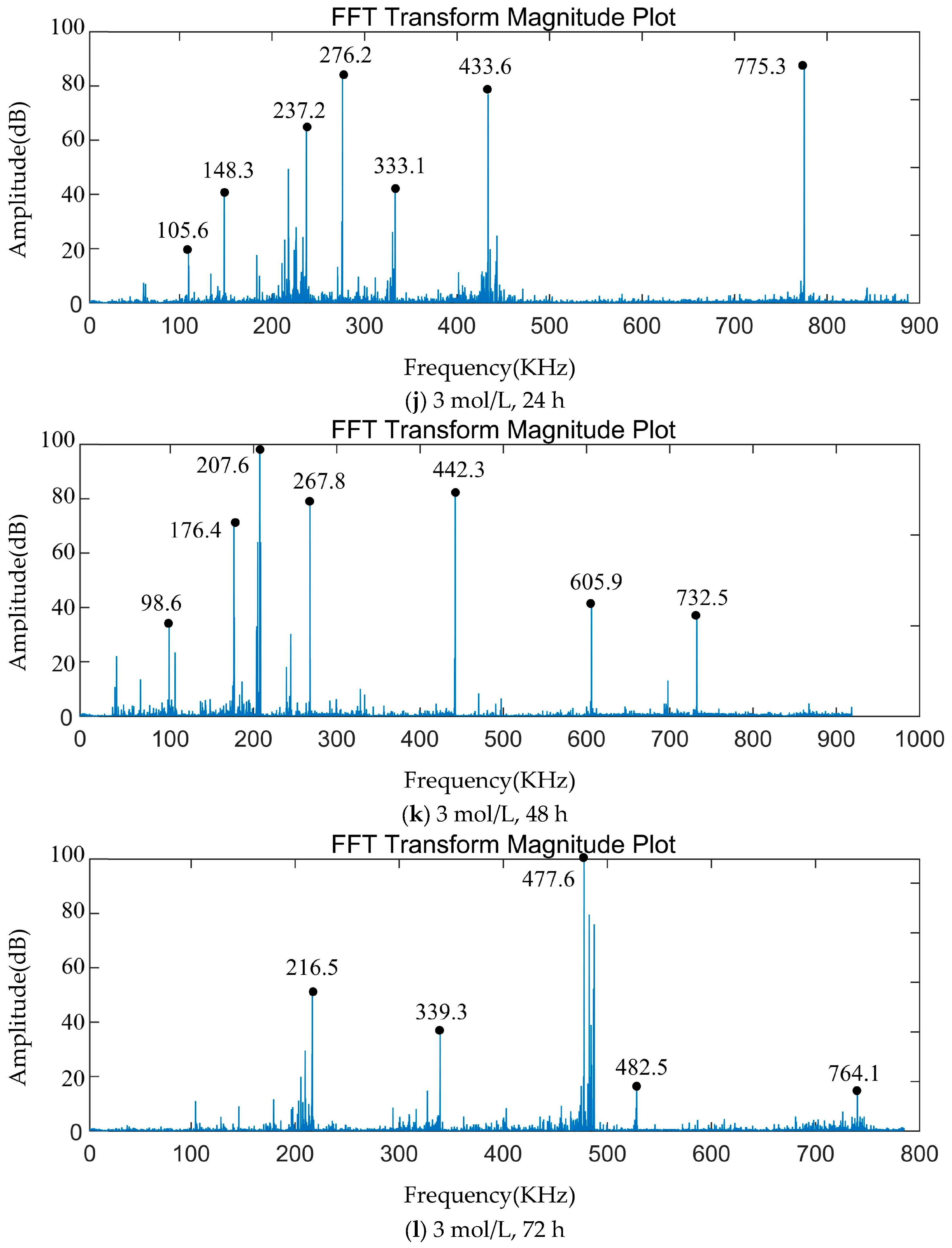

| Name | Parameter Specification or Model | Manufacturer |
|---|---|---|
| Glass fiber | Plain weave, thickness of 0.25 mm, warp density of 34 ends/10 cm, weft density of 26 picks/10 cm, Warp and weft yarn density of 450 tex | Jushi Group Co., Ltd. (Jiaxing, China) |
| Vinyl ester resin | SWANCOR 901, styrene type | Guangzhou Yuexing Enterprise Co., Ltd. (Guangzhou, China) |
| Acetone solution | The mass fraction is 99.55% | Guangdong Wengjiang Chemical Reagent Co., Ltd. (Guangzhou, China) |
| Anhydrous ethanol solution. | The mass fraction is 99.5% | Jiangsu Qiangsheng Chemical Function Co., Ltd. (Changshu, China) |
| NaOH solution | The mass fraction is 95%, granular | Hangzhou Mick Chemical Instrument Co., Ltd. (Hangzhou, China) |
| Electronic single fiber strength machine | YG001A | Zhejiang Sanshouji Instrument Co. (Wenzhou, China) |
| Universal material machine | MTS | MTS Industrial Systems (China) Ltd. (Shanghai, China) |
| Acoustic emission instrument | PAC | American Physical Acoustics Company (Beijing, China) |
| Scanning electron microscope | JSM-5610LV | Japan Electronics Co., Ltd. (Tokyo, Japan) |
| Parameter | Setting Value |
|---|---|
| Threshold/dB | 40 |
| Sampling rate/MSPS | 1 |
| Peak definition time (PDT)/µs | 50 |
| Hit definition time (HDT)/µs | 100 |
| Hit locking time (HLT)/µs | 300 |
Disclaimer/Publisher’s Note: The statements, opinions and data contained in all publications are solely those of the individual author(s) and contributor(s) and not of MDPI and/or the editor(s). MDPI and/or the editor(s) disclaim responsibility for any injury to people or property resulting from any ideas, methods, instructions or products referred to in the content. |
© 2024 by the authors. Licensee MDPI, Basel, Switzerland. This article is an open access article distributed under the terms and conditions of the Creative Commons Attribution (CC BY) license (https://creativecommons.org/licenses/by/4.0/).
Share and Cite
Ming, L.; He, H.; Li, X.; Tian, W.; Zhu, C. Study of the Effect of NaOH Treatment on the Properties of GF/VER Composites Using AE Technique. Materials 2024, 17, 1407. https://doi.org/10.3390/ma17061407
Ming L, He H, Li X, Tian W, Zhu C. Study of the Effect of NaOH Treatment on the Properties of GF/VER Composites Using AE Technique. Materials. 2024; 17(6):1407. https://doi.org/10.3390/ma17061407
Chicago/Turabian StyleMing, Lin, Haonan He, Xin Li, Wei Tian, and Chengyan Zhu. 2024. "Study of the Effect of NaOH Treatment on the Properties of GF/VER Composites Using AE Technique" Materials 17, no. 6: 1407. https://doi.org/10.3390/ma17061407





